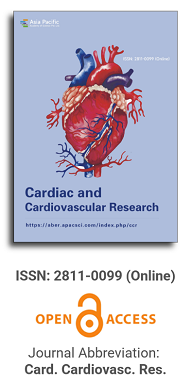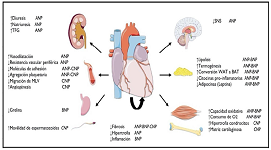
Asia Pacific Academy of Science Pte. Ltd. (APACSCI) specializes in international journal publishing. APACSCI adopts the open access publishing model and provides an important communication bridge for academic groups whose interest fields include engineering, technology, medicine, computer, mathematics, agriculture and forestry, and environment.

Cardiac rehabilitation interventions are becoming increasingly diverse. This issue focuses on a multidimensional research perspective, showcasing the potential of innovative methods in improving heart health and recovery outcomes.
Issue release: 31 December 2022
Introduction: cardiovascular disease in women is underestimated as a health problem. Among the therapeutic options is cardiac rehabilitation, which contributes to the reduction of morbimortality and hospitalization in both genders. Objective: to evaluate the initial behavior and results of a cardiac rehabilitation program in patients attended in the Cardiac Rehabilitation department of the Cardiology service of the General Teaching Hospital "Dr. Agostinho Neto", Guantánamo, during the period 2015–2019. Method: a descriptive, prospective and longitudinal study was carried out. The universe was constituted by 667 patients incorporated to the Cardiac Rehabilitation Program. Risk factors, ergometric parameters given by exercise time, heart rate, blood pressure and functional class were studied. A rehabilitation program was applied that included physical-aerobic and resistance exercises, ergometric tests and serum lipids at the beginning and at 6 months. Results: there is a different risk profile between both genders, obesity is the most prevalent risk factor in the female gender (62.9%) and active smoking in the male gender (78.0%). The improvement of physical capacity was greater in men than in women. The parameters used to improve women's participation and adherence to the program are presented. Conclusions: women have great barriers for incorporation to cardiac rehabilitation programs. It is necessary to provide them with information on the benefits to improve access and permanence in the program.
Issue release: 31 December 2022
Background: There is a great deal of public belief in the cardiovascular benefits of omega-3 fats. Recent trials on the effects of omega-3 fatty acids in cardiovascular issues are unclear or have failed to demonstrate significant benefits in reducing cardiovascular events. The current study aims to perform a human trial using omega-3 fatty acids as a supplementation to test its effectiveness on cardiovascular diseases. Methods: A randomized interventional study was carried out in 145 patients in the age group of 18 or older at any risk of cardiovascular disease. A treatment period of 6 months with supplementation of daily dose of 360 mg of EPA and 480 mg of DHA for one group and to the other group, atorvastatin 10 mg were given. Biochemical and clinical evaluations were performed for the baseline, 3rd and the 6th months to assess the effectiveness of omega-3 fatty acids on cardiovascular diseases. Results: The changes in the biochemical parameters total cholesterol, High density lipoprotein (HDL), Low density lipoprotein (LDL), and triglycerides among the omega-3 fatty acid group and statin group were as 218.17 vs 204.45, 55.24 vs 60.3, 142.9 vs 132.41and 168.95 vs 152.5, respectively with a p value of 0.0001. Omega-3 supplements were shown to have little to no effect on the risk of cardiovascular diseases according to the research. Conclusion: The better evidence identified in this research does not demonstrate any cardiovascular protection with the supplementation of omega-3 fats.
Issue release: 31 December 2022
Objective: To study therapeutic effect of cardiac rehabilitation (CR) combined cognitive behavioral therapy (CBT) on kinesiophobia in patients with acute myocardial infarction (AMI). Methods: A total of 96 AMI patients with kinesiophobia treated in our hospital were divided into CR group (n = 47, were in hospital from September 2020 to January 2021 and received routine CR treatment) and combined intervention group (n = 49, were in hospital from February 2021 to June 2021 and recerved CBT based on CR group), both groups were intervened for three months. General clinical data, scores of Tampa scale for kinesiophobia heart (TSK-SV Heart), anxiety and depression scale and Barthel index (BI) before and after intervention were observed and compared between two groups. Results: During intervention, there was one case dropped out in CR group, and one case dropped out and two cases lost during follow-up in combined intervention group. Compared with CR group, three months after intervention, there were significant reductions in scores of TSK-SV Heart [(36.26 ± 3.16) scores vs. (31.67 ± 3.53) scores], anxiety scale [(7.39 ± 2.05) scores vs. (5.78 ± 1.47) scores] and depression scale [(6.28 ± 2.10) scores vs. (4.65 ± 2.50) scores] and significant rise in BI score [(94.46 ± 4.11) scores vs. (96.41 ± 3.60) scores] in combined intervention group (P < 0.05 or <0.01). Conclusion: CR combined CBT can significantly improve daily self-care living
Issue release: 31 December 2022
Introduction: The identification of vulnerable population groups through active screening aims to prevent infection through different measures or interventions. Objective: To characterize COVID-19 vulnerable older adults with a personal history of cardiovascular disease. Methods: An observational, descriptive and cross-sectional study was carried out in the Family Medical Clinic 3 of the University Polyclinic “Manuel Piti Fajardo Rivero” in the province of Las Tunas from March to July 2020. The universe consisted of 90 older adults with a personal pathological history of cardiovascular disease aged 65 years or older, working with all of them. Results: Female sex was predominant (70%) and the age group from 65 to 70 (35.6%). According to personal pathological history, 100% of the older adults were hypertensive, and 70% presented cardiovascular diseases other than arterial hypertension. Eighty-five point seven percent of the patients maintained regular therapeutic adherence to the treatments for the underlying diseases. Sixty percent of the patients were compensated during the study period. Conclusions: The vulnerable older adults with a history of cardiovascular disease were mainly women. Arterial hypertension was shown to be the main cardiovascular history. Regular therapeutic adherence and compensation of the baseline disease was common in patients.
Issue release: 31 December 2022
Objective: To summarize the safety and long-term efficacy of epicardial permanent pacemaker implantation. Methods: 69 patients who underwent epicardial permanent pacemaker implantation in Wuhan Asian heart hospital from December 2009 to November 2019 and were followed up at least once after discharge were selected. In 23 children, single chamber pacemakers were implanted through right ventricular epicardium; Among 46 adults, 19 were implanted with pacing electrodes through left ventricular epicardium and 27 through right ventricular epicardium. Follow up the changes of electrode parameters and adverse events within 1 week, 1~3 months, 1~3 years and more than 5 years after operation. Results: Right ventricular electrodes were fixed in 50 cases, of which 37 cases were fixed on the right ventricular diaphragmatic surface and 13 cases were fixed on the right ventricular outflow tract; the left ventricular electrodes were fixed in 19 cases, of which 15 were fixed in the lateral wall of the left ventricle, 2 in the posterior wall of the left ventricle, and 2 in the diaphragmatic surface of the left ventricle. The median follow-up was 48.6 months. All 69 patients were discharged smoothly without operation related complications. Two patients with giant left ventricular cardiomyo pathy died of heart failure after cardiac resynchronization therapy (CRT), and one patient with CRT implantation underwent heart transplantation 12 months after operation because of poor efficacy. The pulse generator was replaced in 12 cases because the pa cemaker battery was exhausted. Electrode breakage occurred in 4 cases, and bag infection occurred in 1 case. The ventricular thresholds (median) within 1 week, 1~3 months, 1~3 years and more than 5 years after epicardial electrode implantation were 1.0 v/0.4 ms, 0.75 v/0.4 ms, 0.8 v/0.4 ms and 1.0 v/0.4 ms respectively. The left ventricular epicardial electrode threshold was the same as that of the right ventricle, and that of children and adults. Conclusion the parameters of epicardial electrode are stable for a long time, but the safety is not good

Prof. Prakash Deedwania
University of California,
San Francisco, United States





 Open Access
Open Access